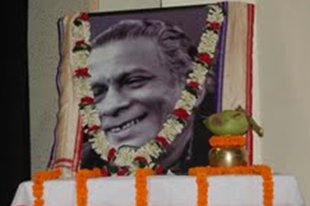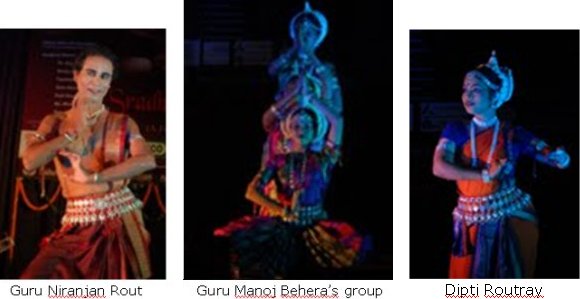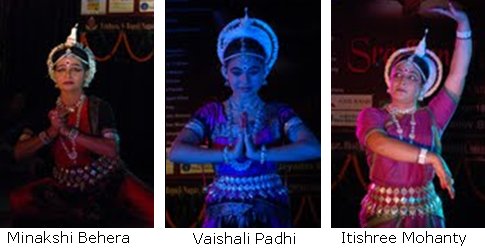
|   |

|   |
Sradhanjali Samaroha: The 25th death anniversary of Guru Deba Prasad Das - Prof. (Dr) SK Nanda, Kolkata e-mail: drnandask@gmail.com August 19, 2011  Guru
Deba Prasad Das’s twenty-fifth death anniversary was observed on 16th
July 2011 at Suchana Bhavan, Bhubaneswar. The program was divided into
two sessions. At a discourse arranged by Tridhara, luminaries from the
field of arts, drama, and theatre like Dr. Dinanath Pathy, Dr. Ramesh
Panigrahi, Ashim Basu and Prof. Kartik Rath were the main speakers. The
session began at 11am with lighting of the lamp by the dignitaries on
the dais and was presided over by Simachal Panda. Some of the senior
disciples of Guru Deba Prasad Das also spoke on the occasion and the
topic of discussion was the contribution of Guru Deba to Odissi, his
style of Odissi and his life history. Guru
Deba Prasad Das’s twenty-fifth death anniversary was observed on 16th
July 2011 at Suchana Bhavan, Bhubaneswar. The program was divided into
two sessions. At a discourse arranged by Tridhara, luminaries from the
field of arts, drama, and theatre like Dr. Dinanath Pathy, Dr. Ramesh
Panigrahi, Ashim Basu and Prof. Kartik Rath were the main speakers. The
session began at 11am with lighting of the lamp by the dignitaries on
the dais and was presided over by Simachal Panda. Some of the senior
disciples of Guru Deba Prasad Das also spoke on the occasion and the
topic of discussion was the contribution of Guru Deba to Odissi, his
style of Odissi and his life history.Dr. Panigrahi was the first speaker. He stated that less number of people see dreams in life and very few realise the dream into action but Guru Deba Prasad Das was one among them who not only saw the dream but also contributed in bringing up the present day Odissi dance. He had great knowledge of talas, stage etc. Guru Deba Prasad was born in 1932 in Kantapara, near Cuttack. His mother died when he was just two years old and his father, a police inspector, due to the nature of his duties, was rarely available at home. The young Deba Prasad was thus brought up by his grandfather who was an artist in a Jatra party in the village, where he played the violin, and could also sing and mime. Watching him every day, Deba Prasad Das picked up all he could and enjoyed imitating him. When Deba Prasad was six, his father married again and came to stay in Puri. Here the boy was sent to school. Near the school there was an akhada; Mohan Chandra Mohapatra was in charge of that akhada. Deba Prasad went there every day, to learn singing and dancing. This continued for six years, although he was not a regular akhada protégé. Under the guidance of Radha Raman Ray, the music director of New Theatres, he joined there at the age of 14. His salary was fixed at one rupee per month, plus food and one anna per day as pocket allowance. His first duties were to place a pot of water daily in the green room, to help prepare costumes, ornaments and make-up box of the senior performers. He was not allowed to dance. Ajit Das, the dance director, from the outset condemned him as unsuitable for dance. Deba Prasad immersed himself whole-heartedly in whatever he was told to do, and that won him much affection. He was promoted to man the gate, check tickets, and was also able to pick at least 4 annas a day. As he saw the dance-dramas day in day out, he knew the dialogues by heart. So once, when the prompter suddenly fell ill and no replacement was available, Deba Prasad was offered the job. He acquainted himself well so he was made a standby prompter in addition to his other duties, and his salary was raised to Rs 31 per month. Later, Guru Pankaj Charan Das joined the New Theatres, where he himself danced and also composed dances. For sometime Deba Prasad's guru, Mohan Mohaptara, also choreographed items. With this Deba Prasad got a chance to perform. Before the curtain rose on the drama every evening, the stage showed a large artificial lotus bloom, in the heart of which was seated a performer representing Goddess Saraswati. The role was taken by a young girl in the party, Nabina, and Deba Prasad came dressed as a girl, holding a lit oil lamp and with dance movements offered homage. This act became regular, no matter what was the theme, so Deba Prasad had a role and his salary was raised to Rs.71 per month. After New Theatres was closed down, Deba Prasad moved to Annapurna ‘A’ and then to ‘B’ and left the theatre in 1951. With Indrani's projection of her Guru Deba Prasad in 1957 at her residence, a show attended by connoisseurs like Kapila Vatsyayan, and Charles Fabri, all agreed this style had distinct flavor. On Feb 19 and 20, 1958, Indrani made her debut in Odissi. The performance was sponsored by Little Theatre Group and this was the first time a full evening of Odissi (of Deba style or any other) was seen outside Odisha. Around that time Indrani's fortuitous selection as Miss India also added to her name and to Odissi's fortune! Deba Prasad thus took Odissi out of its limited setting and made it national and soon his partnership with Indrani made it international. The second speaker was Prof. Rath. He said that he was more interested in theater, but when Deba sir was in Sangeeta Mahavidyalay in association with Kabi Kalicharan Pattnaik he came in contact with Deba sir and he was highly impressed with the knowledge of loka nritya and the depth of knowledge in Odissi dance of Deba sir. Third speaker was Ashim Basu. He said his association with Guru Deba Prasad was not very long but he appreciated that Deba sir was not only an nritya guru but also an exceptional artist. Deba sir used to come to see drama in Rabindra Mandap and observed the stage arrangements too. Dr. Dinanath Pathy was the fourth speaker. He said he was a good friend of Deba sir and is also from the same village where Deba sir’s in-laws reside. He appreciated Guru Gajendra Kumar Panda and said as a son he is observing the death anniversary every year and is having a great role to spread and keep alive the legacy of Deba Prasad Das. Even though Deba Prasad had a good number of disciples, very few were present. He expressed his concern as to why all disciples are not together to observe the day. Secondly he said that by just dancing, Deba Prasad style of Odissi cannot be popularised. No one shows any interest in documentation of Deba Prasad style. He requested all senior disciples to provide papers on the style of Deba sir and he would arrange to publish the same through Angarag. After the senior disciples, the Deba Prasad style will itself perish away. He also expressed concern over why Govt. of Odisha, Sangeet Natak Akademi and Odissi Research Center are not observing the Guru’s death anniversary. Further he requested Guru Gajendra Panda to put forward the proposal to Govt.of Odisha to include the name of Deba sir in the list of artist names enlisted by the Govt. He stressed that the abinaya in Odissi dance is from Sakhi Natta of Ganjam and when comparing the three styles of Odissi, he said Kelubabu style is of Cuttack Durga medha, Pankaj Charan Das style is Puri Sahi Jatra type and Deba Prasad style is Ganjam Thakurani Jatra type. Gurus Sudhakar Sahoo, Niranjan Rout, Harihara Mohanty spoke about how Guruji collected information and incorporated the sabdaswara pata in his style of dance. Dr Sujata Mishra remembered how Guruji was precise in performing abhinaya. Guru Somanth Pradhan said Guruji was very much particular about Viniyoga. Aditya Mahaptra had the opportunity to see a performance of Guru Deba Prasad and was impressed with his style. In the evening session, Sri Ashok Kumar Tripathy, Principal Secretary Tourism and Culture, Govt. of Odisha was chief guest and Dandapani Mishra, Publisher of ‘Dharitri’ was present on the occasion. Tripathy honoured the artists and some of the senior disciples of Guruji. He assured them that from coming year onwards, Govt. of Odisha will take initiative to observe the Jayanti and death anniversaries of the three main gurus of Odissi dance. He appreciated the role of Tridhara and Guru Gajendra Panda in taking active lead in organising functions for propagation of Guru Deba Prasad style of Odissi dance.  Sriya Acharya, a disciple of Guru Gajendra Panda, presented ‘Navarasa,’ one of the masterpieces of Guru Deba Prasad. Because of his intelligence (panditya) and in-depth knowledge of Odissi dance, Guruji was able to choreograph the ‘Navarasa’ by presenting the story of Ramayana. It was directed by Guru Gajendra Panda. But frankly speaking, there was no rasa (emotions) in the navarasa. I would say that more experience and maturity was required. The next performance was by Guru Niranjan Rout, who performed one of the purushaanga abhinaya pieces “Aja Ki Gumana Re” written by Kabi Surya Baldev Rath. Here the nayika asks her nayaka. “Hey, you look very upset today? I have never seen you like this even in my dreams…” It was a good performance though there was some miscommunication between the dancer and the accompanists.   The program concluded with the performance of a group of three junior disciples of Guru Manoj Behera. They performed “Ganesh Tandav” choreographed by Guru Deba Prasad. In this dance piece, I found a very rare song “Tandava nrutya kare gajanana,” which is used in the beginning of Prahalad Natak and Sakhi Natta of Ganjam district. The vast collection of Guru Deba Das from the folk dances and tribal dances of Orissa is alive through his nritya parampara. I was very fortunate enough to be a part of this festival. |